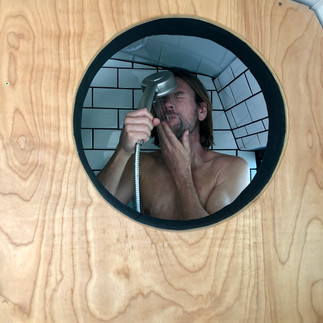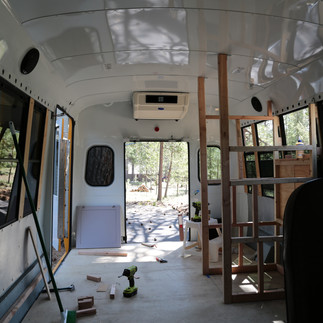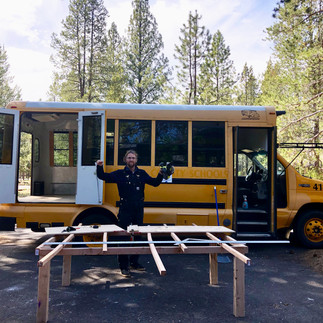Salt Ghost tinyhome and skoolie bus conversion.
- Submarine With Wheels
- Sep 6, 2022
- 14 min read
Updated: Jan 10, 2023

Salt Ghost bus remains the ultimate achievement of Henning and I combined (so far). Neither of us anticipated the tedious hours of labour or bittersweet feelings of frustration, anger and love that go into building our first home together. It was a test for our seven-month young relationship, plus it didn't help to throw the struggles that COVID-19 through into the mix. These included the uncertainty of future travel, the fear of contracting the virus, a brink of a civil outbreak due to Black Lives Matter riots, and the many months of just us in social isolation and lockdowns in a foreign country. The year of 2020 stripped us bare. It broke down all personal space barriers and revealed the best and worst of ourselves in times of the unknown. It was exciting, challenging, and a test of patience but ultimately rewarding. Salt Ghost was our heart and soul, our non-stop project for six months and home for almost a year. Our trusted stead took which kept us safe and drove us across the country to many stunning national parks. Salt ghosts' memoir may have taken over a year to publish – but it is well worth the wait.
Salt Ghosts' life existence began in March 2020. Henning and I had been in Australia for three months, meeting my family and attending my best friend's wedding in New Zealand. Mid-March we had been due to fly to Los Angeles for one of Hennings's friend's 30th birthday in Venice Beach. A week before our departure date, the news of the COVID-19 virus began circulating on the news. At first, I was one of those ignorant people who brushed it off as the flu, and we questioned whether to stay or go. A few days before we left, I felt I couldn't shake. I trusted my gut, and we took our chance to leave Australia. The only thing on my mind was returning to The Submarine With Wheels bus, which was patiently awaiting my return after being in storage with the Panamanian government since October 2019. I knew my only chance to rescue the Submarine With Wheels was to fly to the United States immediately.
However, like everyone in the world, our life plans quickly flipped. COVID-19 misinformation began to impregnate fear into society. A highly infectious bat virus had gone rogue straight from Wuhan, China. Our plans went down the drain when we landed in Los Angeles, California. The 30th birthday party got cancelled, and the friends we were to stay with fell through. We were alone with the end of the world in sight. Luckily, we got taken in by our friend farmer John at his place in Ventura, close to Rincon surf break. While the world bought every packet of toilet paper available and went into lockdown, we crashed on a couch in a twelve-person share house overlooking the ocean and evergreen avocado farms.
To make our situation worse, Australia declared a stage four travel ban and closed their borders, and Panama closed their entrance to all foreign tourists. We didn't know what to do at this point. The only logical thing we thought was to buy a vehicle and drive south to Panama. With that agreed, we searched for our adventure home.
After long contemplation and discussions over the thoughts of a van, car or bus, Henning adapted to the idea of travelling in another bus. YES! I was relieved. Living and travelling in anything smaller for one year did not appeal to me. After I had lived for almost two and a half years on the Submarine With Wheels bus measuring 30ft, I knew I needed space, privacy and comfort. With that in mind, we decided on a 23ft short school bus, also known as a skoolie. We scanned the internet and locked eyes on a potential vehicle on the Facebook marketplace. A phone call to the owner, and seven days later, we had hired a car and drove seven hours north to inspect and test drive a bus. Henning and I were now the proud owners of a Ford F450 skoolie bus within a week.
We were thrilled and pumped as we drove our skoolie in those first few hours at night from the buyer. It was slightly snowing and cold. Relieved we were not sleeping on couches anymore, we spent our first night in a Walmart car park. We'd inched our position up in the world slightly. We had a home, a mattress, a blanket and each other. It was far from romantic, but it was all we needed. To our surprise, we soon realised our emergency exit and wheelchair doors had no lock. We locked them with cable ties and a wooden stick. It took us a while to fall asleep as we felt uneasy by the late-night tweekers roaming the parking lot. After a cold and restless night's sleep in the morning, we took a selfie photo. It's hilarious and sums up our journey ahead. My face has pure joy and excitement for the future ahead. Henning stares at me blankly with an expression that screams, what have you led me into? Have we made a mistake? Maybe. Are we crazy to be doing this? Possibly. But we were unaware of the incredible stories, adventures, and opportunities that awaited us due to this skoolie. Consequently, we had a vehicle but no location or tools to renovate.
Consequently, we had a vehicle but no location or tools to renovate. Next was to find a building location. Fortunately, we got to stay in a luxurious snow lodge with a sauna that backed onto a golf course in Sunriver, Oregon. The house was family-owned by a friend Kat, who I met on workaway.com and lived on the Submarine with Wheels bus with me in Playa Venoa, Panama. For a month, Kat, and her broken leg and crutch, hung out on the bus and by the beach, encouraging me while I repaired and painted the roof. We partied with my sister and Henning and drank many tequila cocktails enjoying the craziness and freedom of bus life. We completed the second half of the build in northern California at our close friends Kim and Jason's house and their furry companions, including a cuddly and playful golden retriever Kiaro and an energetic, non-stop barking pooch named Cuzco. When taking breaks from building, we would all venture down to the gorgeous Yuba River for a picnic, go hiking, or explore their local area with their boat. Both locations were beautiful, and we feel blessed to have such great friends.
Due to the outbreak and spread of COVID-19, local restrictions were in place. Lockdown meant we could only leave our house for all essential reasons. All we required to complete our conversion was food, tools and building materials. Home Depot, the national building and construction chain, gratefully remained open. Home Depot became our weekly Sunday visit. We referred to it as 'church', as it was our sole purpose to venture out into the world each Sunday. Due to the fact we landed overseas with just our backpacks and surfboards, we had to purchase every tool and material required. Amongst the many supplies we needed, our cheap but durable Ryobi cordless set of power tools were our first and most appreciated purchase.
Now that we have established the above history, let's talk about the bus conversion: demolition, planning and construction. From personal experience, the demolition process is the bomb! You don't have to be super careful about keeping things intact; breaking things is my speciality if you know me. It is the fun step in a build and includes dismantling parts, revealing surprises and deciding what stays and goes to trash or recycling. In this step, we learnt about the highly confusing bus wiring and frame structure and got a brief idea of the project we were working on. Removing the wheelchair lift was one challenge that required extreme attention from a heavy-duty angle grinder. It was worth the tedious removal as we sold it back to the community on the Facebook marketplace.
I never anticipated planning would be so exciting but also very tiresome. It consumed our life from the moment we woke until we slept. It even crept its way into my dreams. However, with an empty bus shell, it was exciting to walk up and down the aisle, envisioning our future dream home. It was clear from the start; that our layout would keep all the windows uncovered for 360-degree visibility when parked in nature. We envisioned an open-spaced living with lots of room to relax without feeling cramped by walls or doors. It was to be a fully functioning off-grid tiny home with a toilet, shower, fridge, oven, dual sink, solar panels, electrical system, bed, and couches.
One of the many challenging concepts was to be the location of our six surfboards. In particular, an 8ft long board I was gifted from close friends and family for my 30th birthday. We had many imaginative locations, such as, under the kitchen, on the roof or under the sofa. Yet, all these locations blocked the living space, and we eventually realised the most straightforward solution was tucked away from sight under the bed, in a place we named the garage.
Insulating the bus, we decided against due to the loss of heat and cold that would pass through the windows, and this saved us from a massive process of messy spray foam extravaganza. However, Nadine created one independently when sealing the external drainpipe holes.
Nadine: "How does this spray foam work?"
Henning: (In a very stern voice) "Nadine, be careful with that; open it outside."
Nadine: "It's not working, I've shaken it, but nothing's coming out."
Henning: "Be careful!"
Nadine: Opens safety cap and foam sprays all over the wall, window and roof. Oops! Well, I guess it's working."
In our professional careers, Henning is an architect, and I was a cosmetic nurse. We were not a reckoning building team and were numerous times out of our comfort zones. We learnt to accomplish jobs like this - build, fail, undo, rethink, rebuild, and then succeed. It was a common occurrence we had to tackle the same job twice. Unfortunately, examples of this were the not-so-fun and easy tasks that wasted hours or days. Such as Henning angle grinding through the thick 2-inch metal frame for the drainpipe only to realise we were just inches off aligning up with the windows. Or building the shower frame twice; the first time I made it alone, it wobbled when we walked past it and was on an angle. Lastly, Henning dismantled and constructed the bed three times due to multiple plan adaptions.
After travelling without a shower for over two years on the Submarine With Wheels bus, we needed to build a bathroom and shower. No matter how difficult the task, I needed to have a space to rinse daily. I will be honest; I was a building rookie, and building a shower, the language that comes with plumbing parts and multiple measurements of tiles was challenging to comprehend. But the only way to learn new skills was to jump into it headfirst.
The extra work and struggle the shower bought was worth it. Those days we could remove a wetsuit inside from the wind and have a hot shower immediately after a cold winter's day, surf in Santa Cruz or Oregon was absolute heaven. Also, a little portable cassette toilet made urinating in the middle of the night extraordinarily convenient and comfortable. Number twos were always done outside the skoolie in public bathrooms, restaurants or nature.
We would spend the whole day watching YouTube tutorials or Instagram for inspiration. Henning was the master builder throughout our project, drawing designs and planning precise measurements. Anyone who has built in a confined space knows that every inch counts. His designs saved inches wherever possible, giving more space for draws, surfboard storage, seating and bed space. For both of us building in the imperial system was like learning another language. Trying to adjust to this strange and foreign concept, Henning changed his screen saver to a zoomed-in Inch tape measure as a daily reminder of the confusing quarters, eighths and thirds of the inch.
During our plan layout, Henning, with his abstract architecture mind, mentioned why not have a feature through our bathroom wall visible from the exterior. Initially, we thought the idea would be impossible, an 18-inch circular hole in a tiled wall. It was a unique concept, and I was up for the challenge.
I pondered the idea for days. Youtube and the internet hadn't provided any tips or instructions on this idea. How could I plan a structure we had never seen built before or constructed? I woke one morning with a vision full of imagination. Multiple layers of drywall screwed together with flexible grouted. On the inside, it looked more like a kid's attempt at arts and crafts. Nevertheless, determination and imagination worked like a charm. Once, it was mounted, and after a few layers of grout and paint, there was no evidence of a creative building.
Tiling the shower was my masterpiece. Due to the constant movement of the bus, flexible grout gave us the confidence our tiling work wouldn't crack. Precision and patience were how I learned to shape the circular cuts for the tile work all done with a hand tool. I didn't realise that black grout is incredibly messy, and it sniggles and stains anything it comes into within contact. It was bye-bye to my work overalls and shoes. But the mess was necessary. It was a unique feature of our tiny home.
As mentioned above, we dreamed of lots of space on the bus. For this reason, we kept a large enough aisle for two people to walk freely past each other, unlike the cramped Mercedes sprinter vans or RVs in which people have to dance around each other for everyday tasks. The kitchen bench allowed two people cook with plenty of draws for food and storage. Our favourite secret was building an inverted space behind the oven where we could stand oils and spices for easy access while cooking. The Dometic fridge was our lifesaver. Small but mighty, it could compact a week's worth of food inside with a freezer and ice cream. I'll never forget when the moment when we parked in prime view of the golden gate bridge. We took in the picturesque view while eating homemade affrogatos made of freshly made espresso and pistachio ice cream. Delicious!
The following household item was Henning's and my favourite appliance on the bus. A cute and compact little two-burner stove with an open-face oven produced by Camp Chef. That little oven gave us many tasty potato bakes, roast dinners, cakes and lasagnes. Once we discovered Trader Joe's frozen almond croissants, we were in heaven. We could prep our croissants during the cold months and let them rise in the oven overnight. In the morning, they could be cooked by simply reaching from bed to warm the oven. The heat would toast up the bus, and we could wake to freshly toasted pastries.
For most bus or van conversions, the idea of energy consumption is always a question of whether it will be enough. Batteries, solar panels and supporting equipment can run into the thousands. Doing research and consulting our electrical genius friends, we bought one Battle-Born lithium battery, a Victron charge controller and their Bluetooth screen display. To fuel those components, we mounted a 350-watt Renogy mono-crystalline solar panel to the roof. This combination was the perfect amount to keep our lights, ceiling fan, fridge and charging ports running with no problems, even during winter or overcast days. While most diagrams and talk of electricity went over my head, I thoroughly enjoyed the practical part of piecing and building every electrical lug and wire connection.
On the road, there is a lot of downtime, so we decided to have two couches, his and hers. On the rare occasion, we would have another passenger or want a leg rest; there was the option they could join together. Under the sofas was our wardrobe, four slide-out draws. I got my hands on a sewing machine and was able to sew sofa covers over 6-inch foam, cushions and curtains for all windows.
Water capacity is another crucial component of a build, and this was something we knew more was always better. Being a school bus, we didn't worry about a little extra weight as the chassis and dual wheelbase could handle the load. For that reason, we opted for a 42-gallon water container joint to a water pump and an instant gas heater to provide hot or cold water to the shower and sink. For drinking water, a handheld pump connected to two 5-gallon bottles under the sink is vital to have interchangeable purified water when travelling through countries in Central America.
In our eyes and others, painting the exterior of the bus was a must to not stick out like a sore thumb with the bright yellow school bus colour. Thankfully, we had the help of a pressure hose to clean it thoroughly and remove a build-up of grime and dust that had settled into light fixtures, seals and the roof. As Henning was the master builder, I was the apprentice taking on the fiddly time-consuming tasks he did not like. Such as the painting preparation. Stripping the original bus letters, stop signs and reflective stickers required time and patience. Patience and some more patience. The whole prepping process took at least a week, and I was covered in fine dust daily after sanding.
Although I wished to have matt black painted on the exterior, the idea of baking in the sun in Central America was not ideal. I even had a genius idea which I only embarrass myself and write this down for Henning's request. One morning I suggested, "Why not paint an undercoat of white reflective paint then matt black over the top". For the very logical reason it would never work, Matt black never came to fruition. Instead we used an off white long-lasting exterior house paint with a spray gun to apply a primer and colour to the bus. We applied two coats of thick RV roof paint on the roof as a roof heat preventative and waterproofing layer.
Whether it was the fear of COVID -19, missing our friends and family or just being around each other for too long, we turned slightly crazy. Not mental crazy, just silly. We had no one but ourselves to entertain us, and things got boring fast. It seemed like the only thing we had to make conversation about was the build. Like everyone else, we had been locked up like chickens inside their pens. At times, our minds went delirious. One day while cooking I dropped too much salt on the bench. Henning pointed out it had eyes a face and looked like a ghost. Somehow it became a thing. The Salt ghost.
We left last the biggest project of our build and the worst job we tackled. When we first inspected the floor, it was mould and rust-free, so we decided to lay thin plywood over the top. We rubbed it with linseed oil and thought it would be complete. We didn't realise over the next few months that the new floor would get heavily stained from dirt. Our foundation blended into the furniture and looked like a sad and outdated 1950s caravan.
We sadly regret not doing the following job much sooner in the build. Regardless, once we started to pull up the plywood in the aisle area, we discovered the steel tracks on which the passenger seats had been mounted. It required one person inside the bus and the other underneath it as we unbolted the chassis to dismount the tracks. It became a very unpleasant when we realised half of the bolts had rusted and snapped off. To our disappointment, it took many painful hours angle grinding 26 bolts from the floor during one of many summers 100-degree Fahrenheit heatwaves. Undoubtedly, this was our melting point, a battle with the bolts, and the floor was winning. As the day progressed, we were sweating and swearing, sparks were flying everywhere, and our hands were shaking from holding the grinder for so long. We were losing patience. Finally, we succeeded after taking turns to angle grind the bolts and showed the bus who's boss – us!
During the six months and countless hours of construction, there were numerous additional tasks and projects we built I was not able to mention. Although I hope through the photos, I can recall the many beautiful details and features we made. It is impossible to put our feelings and words on paper that precisely capture the amount of labour and love which goes into a project this big. Yet, in the end, the constant work and emotional rollercoaster of spending every waking hour of every day as one made us more resilient and robust. Looking back at the fantastic job we achieved, I am proud of our achievement of completing the entire build ourselves.
Even though that task is over and complete, we are continuously eyeing other vehicles and dreaming about the next project and build for the future. Salt Ghost shows our creativity, passion for travel, and ongoing commitment to adventure no matter what curve ball life throws our way. Living in it for the time we did was fantastic and unforgettable. I will never forget our humble home and the places it took us, the struggles it created and the obstacles we took to overcome because of its existence. Salt Ghost was our most significant triumph .... and won't be our last.
































































































Comments